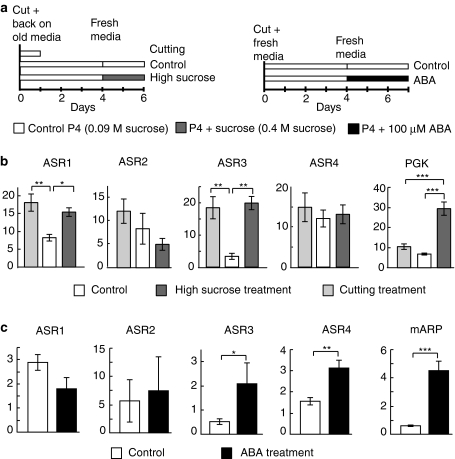Fig. 6.
Regulation of the mAsr members following exposure to sucrose, wounding (cutting) stress or ABA. The relative mRNA abundance of mAsr1 to mAsr4 was measured by quantitative RT-PCR on meristem cultures of the ‘Cachaco’ cultivar (ABB). For each member of the mAsr family, mean relative abundance values were compared to each other on a pair-wise basis using Student’s t tests. Standard errors are represented. Comparisons that were significant are indicated by one, two or three asterisks depending on whether the P value was <0.05, <0.01 or <0.001, respectively. a Schematic view of the treatments applied to each of the sample types. For the “sucrose experiment”, samples were cut on day 0 and put back on their respective standard growth media. The “cut” samples were harvested the next day. The other two types of samples were transferred to fresh medium (either standard growth medium or standard growth medium supplemented with 0.4 M sucrose) on day 4 and harvested 2 days later. For the “ABA experiment”, samples were cut on day 0 and placed on fresh growth media. On day 4, they were placed on either fresh standard growth medium or fresh standard growth medium supplemented with 100 μM ABA. Samples were harvested 3 days later. b Comparison of mRNA abundance in the different sample types illustrated in a: control (white bars), cut (light gray bars) and high sucrose samples (dark gray bars). The two reference genes used for normalization were EF1α and actin11. The expression of phosphoglycerate kinase (mPGK) was used as a positive control c Comparison of mRNA abundance in meristems grown on standard growth medium (white bars) or grown on standard growth medium supplemented with 100 μM ABA (black bars) for 3 days before harvest. The two reference genes used for normalization were actin11 and L2. The expression of an ABA-responsive protein (mARP) was used a positive control

